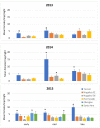Differences in Longevity and Temperature-Driven Extrinsic Incubation Period Correlate with Varying Dengue Risk in the Arizona-Sonora Desert Region
- PMID: 37112832
- PMCID: PMC10146351
- DOI: 10.3390/v15040851
Differences in Longevity and Temperature-Driven Extrinsic Incubation Period Correlate with Varying Dengue Risk in the Arizona-Sonora Desert Region
Abstract
Dengue transmission is determined by a complex set of interactions between the environment, Aedes aegypti mosquitoes, dengue viruses, and humans. Emergence in new geographic areas can be unpredictable, with some regions having established mosquito populations for decades without locally acquired transmission. Key factors such as mosquito longevity, temperature-driven extrinsic incubation period (EIP), and vector-human contact can strongly influence the potential for disease transmission. To assess how these factors interact at the edge of the geographical range of dengue virus transmission, we conducted mosquito sampling in multiple urban areas located throughout the Arizona-Sonora desert region during the summer rainy seasons from 2013 to 2015. Mosquito population age structure, reflecting mosquito survivorship, was measured using a combination of parity analysis and relative gene expression of an age-related gene, SCP-1. Bloodmeal analysis was conducted on field collected blood-fed mosquitoes. Site-specific temperature was used to estimate the EIP, and this predicted EIP combined with mosquito age were combined to estimate the abundance of "potential" vectors (i.e., mosquitoes old enough to survive the EIP). Comparisons were made across cities by month and year. The dengue endemic cities Hermosillo and Ciudad Obregon, both in the state of Sonora, Mexico, had higher abundance of potential vectors than non-endemic Nogales, Sonora, Mexico. Interestingly, Tucson, Arizona consistently had a higher estimated abundance of potential vectors than dengue endemic regions of Sonora, Mexico. There were no observed city-level differences in species composition of blood meals. Combined, these data offer insights into the critical factors required for dengue transmission at the ecological edge of the mosquito's range. However, further research is needed to integrate an understanding of how social and additional environmental factors constrain and enhance dengue transmission in emerging regions.
Keywords: Aedes aegypti; Mexico; age-grading; climate; dengue; extrinsic incubation period; longevity; mosquito; parity.
Conflict of interest statement
The authors declare no conflict of interest.
Figures






References
-
- Christophers S.R. Aëdes aegypti (L.), the Yellow Fever Mosquito: Its Life History, Bionomics, and Structure. University Press; Cambridge, UK: 1960. p. 11.
Publication types
MeSH terms
Grants and funding
LinkOut - more resources
Full Text Sources
Medical

